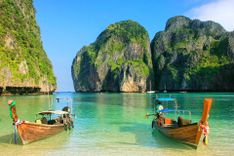Find even more inspiration for Thailand here
Discover Thailand's most captivating stories
Thailand Travel Guide
written by
Rough Guides Editors
For over 40 years, Rough Guides has been a trusted name in travel, offering expert-curated guides, inspiring articles, and tailor-made trips. Our passionate team of writers and local travel specialists provide in-depth insights into destinations worldwide, from iconic landmarks to hidden gems. We help you travel smarter and experience the world authentically.
read more





